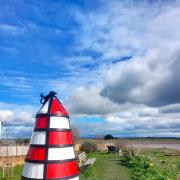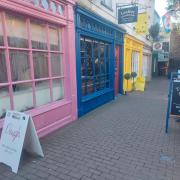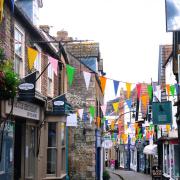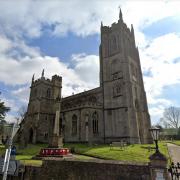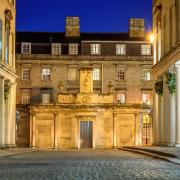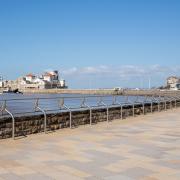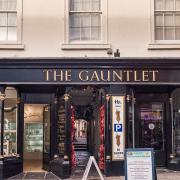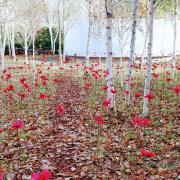Glastonbury, the heart of the mystical Isle of Avalon, is an enchanting place in more ways than you might know, discovers Laurence McJannet

Mention Glastonbury to those who don’t know this colourful market town and instant associations tend to be either with the world-renowned festival that takes place in nearby Pilton most years or with a place of New Age pilgrimage. A place where ley lines converge and Arthurian legends abound, a place steeped in mysticism and populated by druids, white witches and those of an altogether more alternative persuasion.
Indeed, both are ingrained in the character of the town. In all but the occasional year Glastonbury becomes the epicentre of the summer music festival season. It also has its fair share of holistic practitioners and eclectic emporiums selling crystal sculptures and Arthurian figurines, not to mention a rather eccentric local known to many as ‘naked Jesus’. But these are just two strands that make up the unique tapestry of the place – Glastonbury may well be the south west’s capital of alternative culture, but it is many other things as well.
Events
Michael Eavis’ musical extravaganza aside, there are other hugely popular events that help make Glastonbury such a dynamic place. The Fringe Fest, which enjoyed its seventh successful year in June, is gaining recognition as one of the best independent festivals in the south west, with a diverse offering of music, theatre, dance and visual arts. That it chooses to run concurrently with the Glastonbury Festival is testament to its popularity and independent identity.
The Glastonbury Abbey Extravaganza, held each August, is set against the beautiful backdrop of the abbey grounds and is the highlight of the summer season here. This year Paloma Faith is headlining the Extravaganza and tickets have long since sold out.

Places to visit
The abbey is a wonderful attraction at any time of year, though. It’s easy to see as you wander around its impressive remains that this was once one of England’s greatest seats of ecclesiastical power, and it still inspires an overwhelming sense of awe. The abbey now hosts a summer season of outdoor events such as al fresco theatre and movie screenings. Among its 36 serene acres you’ll find the supposed resting place of King Arthur and Lady Guinevere, the abbey museum, a cider orchard and much more. The tithe barn in nearby Pilton is worth seeking out too. The Grade I listed 14th-century barn was built to store produce for the abbey and its spectacular high vaulted ceiling, once destroyed by fire, has been restored to its former glory.

The prominence of Glastonbury Tor – possibly the most famous landmark in Somerset if not the entire southwest – and its importance as an ancient pagan site of worship do much to augment the town’s mystical reputation. Said to be the mythical Isle of Avalon of Arthurian legend, as the Levels flooded, the Tor, towering 158m above the surrounding planes, would indeed have appeared island-like. The summit makes for a bracing half-hour walk from the trailhead at Well House Lane, rewarded with far-reaching views across the Levels from the Chapel of St Michael, now under the auspices of the National Trust.
Chalice Well and Gardens near the Tor is another spot widespread with myth and legend. A pilgrimage site since Celtic times, it is one of the oldest wells in the country, said to be more than 2,000 years old, and exudes a near meditative tranquility, made all the more special during the summer with a programme of music, poetry and performance in its candlelit gardens. It is said to have marked the site of the Holy Grail, and its warm red waters do much to fuel the speculation that the chalice that once caught Christ’s blood at the crucifixion lay here (though it is actually due to the water’s high iron content). Here too is the famous Glastonbury Thorn, a supposed holy thorn tree that, so legend has it, sprang from the staff of Joseph of Arimathea and now blooms each Christmas. Like the nearby White Spring it’s a lovely sanctuary, steeped with spiritual significance, and a perfect place to escape the hubbub of the town.
Another glorious old building is the Tribunal (english-heritage.org.uk; entry is £3 or £2 for children) in the High Street, a 15th century stone townhouse thought once to be the courtroom for the abbey. It also houses the Glastonbury Lake Village Museum, which offers a fascinating insight into the town as it was during the Iron Age. If Glastonbury’s history intrigues you head to the Somerset Rural Life Museum in Chilkwell Street, the most popular museum in Somerset, which tells of the rich rural and social history of the county and offers an engaging experience with a programme of events such as Living History days and this month’s Awesome Archaeology day on July 26 (swheritage.org.uk).
Glastonbury’s unique cultural and spiritual heritage has attracted the attention of the EU’s Enterprise and Industry Directorate General too. It is looking to develop a new pan-European spiritual and cultural tourism route, a modern-day pilgrim’s way based on the legend of the Holy Grail, crossing Bulgaria, Crete, Greece, Malta, Spain, and France, culminating where all the strands of the Grail’s story intertwine – Glastonbury.

Open spaces
Residents here are lucky to have an abundance of beautiful open spaces on their doorstep, easily explored by foot or bike from the town. Collectively known as the Avalon Marshes, like most of the Somerset Levels, it’s a vibrant, working landscape, rich in wildlife, heritage and culture. Verdant meadows, small woods, reed-beds, lakes, pools and scattered villages all contribute to its evocative character. Seen from these watery plains, criss-crossed by a myriad of ditches, rhynes and waterways, Glastonbury Tor seems to stand sentinel over the Levels and the legends of the Isle of Avalon seem to take on a whole new significance.
The marshes are one of the finest remaining lowland wetlands left in Britain. Throughout the year you can catch glimpses of kingfishers, bitterns and great white egrets, while winter’s main attraction is the massive murmuration of starlings, which attracts nature lovers to the Ham Wall nature reserve from all over the south west and beyond. Other nearby nature reserves, which are free to visit, include Catcott (Somerset Wildlife Trust), Shapwick Heath (Natural England), Shapwick Moor (Hawk and Owl Trust) and Westhay Moor (Somerset Wildlife Trust).
Stay over
Whether you are looking for somewhere quirky to stay, or seek something a little more refined, you’ll be spoiled for choice in Glastonbury. You could try the likes of The Covenstead, an eccentric, pagan-themed B&B filled with a riot of oddities, or plump for the more traditional, artfully decorated Magdalene House, once a school house run by nuns perfectly positioned overlooking the abbey grounds. No trip to Glastonbury is complete without a visit to the George and Pilgrim Hotel, a magnificent 15th century inn, the wood panelled lounge bar of which offers a very different but no less satisfying type of sanctuary to the the town’s more spiritual retreats.

For foodies
As you may expect, Glastonbury does a fine line in vegetarian and vegan eateries, such as Rainbows End, a psychedelic cafe that encapsulates the town’s spirit, with plenty of inventive, hearty platters. Or there is Hundred Monkeys, a popular bistro specialising in Fair Trade, local and seasonal produce with numerous gluten-free or vegan options. If you’re looking for somewhere lively, try the Bocabar, a one-time sheepskin factory reinvented as a hip hangout, with live bands, a pan-global menu and a great range of craft beers. A place that perfectly combines comfortable accomodation, good food and a friendly atmosphere is the Who’d a Thought It Inn, a pleasantly peculiar pub swathed in dried hops, and replete with an old telephone box and an ancient bike dangling from the ceiling.
One thing all these places have in common is they exude character and charm, much like the town itself. It’s evident that people have been flocking to Glastonbury for centuries, for the sake of pilgrimage, spiritual healing or enlightenment, or just to work the land on the Levels. While ancient sites such as the Tor and abbey still act as beacons for travellers from afar (the same is true of the festival), the Glastonbury of today has as much if not more with which to entice visitors.






